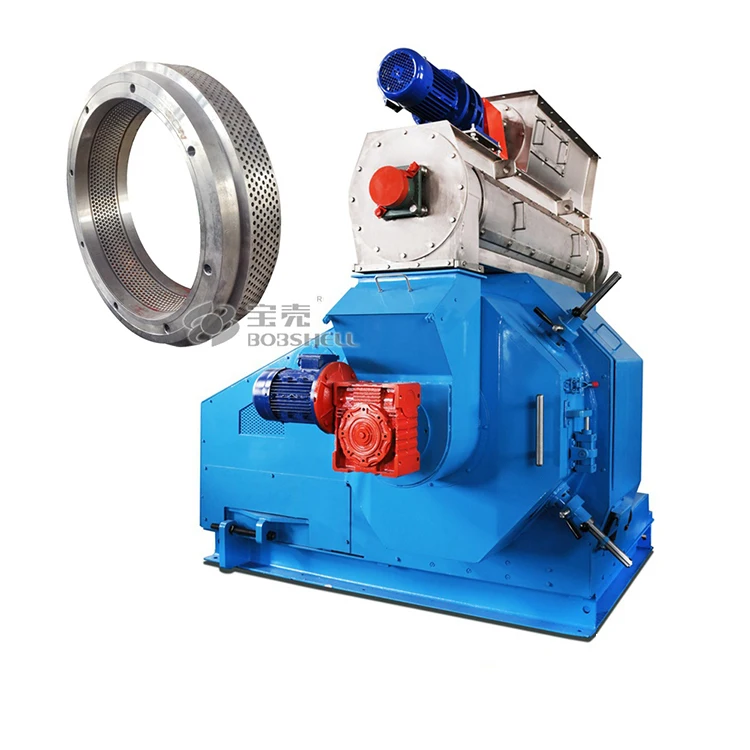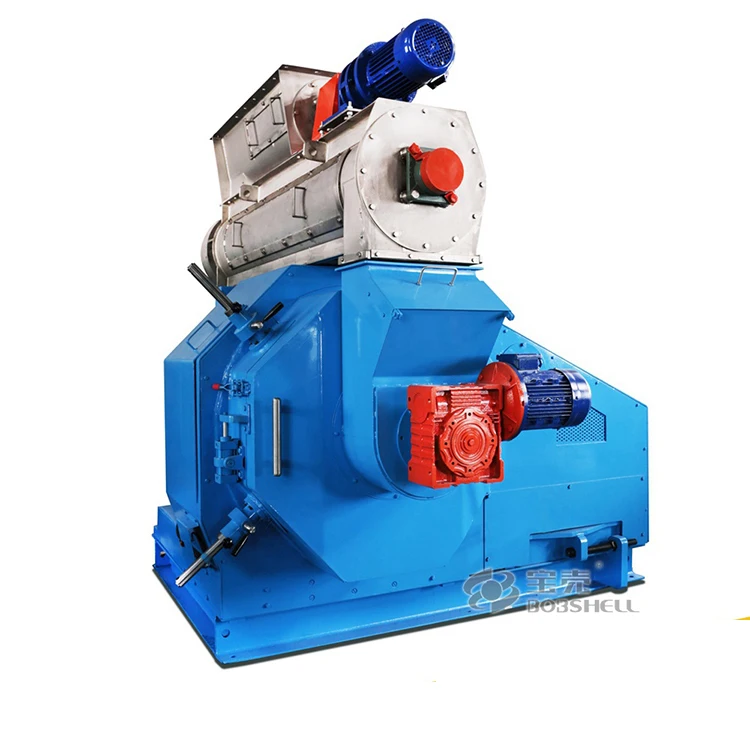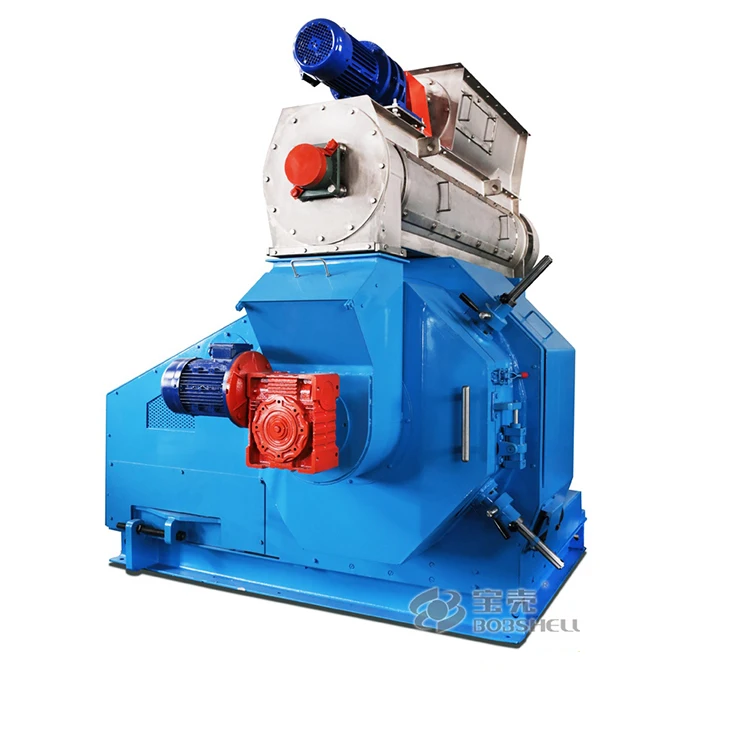Producing wood pellets,animal feeds pellets and other pellets
MOQ: 1 pcs
Delivery time:10 to 30 days after receipt of the advance payment
The entire machine is guaranteed fo r 3 years, except fo r easily worn parts.
Ring die: Working life of bloenergy pellets be 1000 hours, Working life of animal feed pellets be 1500 hours.
All steel from top tier factories will be used
Compliant with GB/T 19001-2016/ISO 9001:2015
The factory covers an area of over 13000 square meters and has two large production workshops and a comprehensive warehouse.
Feed Granulator HKJ300, After investigating the existing feed granulators in the world, considering the different requirements of the applicable objects on the granulated feed, especially considering the characteristics of high hardness and high density of the pressed particles, HKJ annular model feed granulator was designed and manufactured.
The machine has a simple structure, so it can be widely used in small and medium-sized aquaculture, grain feed processing plants, livestock farms, poultry farms and individual farmers.
| Product name | livestock pellet mill |
| Keyword | sawdust pellet mill suppliers,220v pellet mill,pellet mill rolls,diesel feed pellet mill,pellet mill equipment,pellet mill for wood,pellet mill press,vertical pellet mill supplier china |
| Place of Origin | China |
| Rated production capacity | 1253-2000Kgs/H |
| Pellet diameters | 4-12mm |
| Motor power | 160KW(220HP) |
| Screw feeder Diameter | 222mm |
| Invention patent(Ring die wood chip granulator): | ZL 2015 1 0365726. X |
| Ring Die Inner diameter | 520mm |
| Working width | 82mm |
| Working area | 13.39Cubic dm |
| Feature | Supported by Italian Bioenery pellet machine technology of 50 years,High-efficiency Steady Low maintenance cost,More than 10 years working life.. |
| Machine size | 3214mm*2035mm*2124mm, (Contact us for specific information to confirm) |
| Applicable Industries | medium-sized aquaculture,, etc. |
| Color | yellow |
| Weight | 5844kg |
| terms of paymen | Cash,T/T,T/L. |
| Life span | 16 years (Contact us for specific information to confirm) |
| After-sale service | The entire machine is guaranteed for 3 years, except for easily worn parts. |
| livestock pellet mill Advantage | We keep good quality and competitive price to ensure our customers benefit |
| Packing | 3904x2980x3052mm(Contact us for specific information to confirm) |
| Sales country | All over the world for example:Mexico,Sierra Leone,Tuvalu,Guatemala,Puerto Rico,Guinea,Turks and Caicos Islands,Algeria,Comoros |
| MOQ | 2pcs(Contact us for specific information to confirm) |
Delivery time | 10 to 30 days after receipt of the advance payment |



livestock pellet mill
as one of the most professional livestock pellet mill manufacturer has the advantages at:
The company's BOBSHELL brand serial products have accumulated served over 1200 clients around the world and be long-lasting reliable supplier of GF, LA MECCANICA, CPM, BUHLER, ANDRITZ which are world famous firms in Pellet industry.
Hongxing Machinery insists on the mission of "World class quality,serve Chinese clients to expand the markets."Bobshell" parts have gained huge competition advantages in the fields of animal feeds,biomass fuels,chemicals, organic fertilizers etc.
livestock pellet mill services FAQs Guide
Are you looking for a quick review guide about livestock pellet millservices?
An ultimate FAQ buying guide is available to help you.This guide contains all the information about all the important facts, figures, and various processes regarding livestock pellet mill services.
Let’s continue!
1.How does the market demand for pellets affect the livestock pellet mill industry?
We should have a stable supply chain and logistics capabilities, and provide customers with high -quality, low -priced livestock pellet mill products.
The market demand for pellets has a significant impact on the pellet mill industry. As the demand for pellets increases, the demand for pellet mills also increases. This is because pellet mills are the primary equipment used to produce pellets, and as demand for pellets grows, more mills are needed to meet the demand.
The market demand for pellets also affects the pricing of pellet mills. When demand is high, the prices of pellet mills tend to increase due to the limited supply and high demand. On the other hand, when demand is low, the prices of pellet mills may decrease as manufacturers try to attract customers and stimulate demand.
Moreover, the market demand for pellets also drives innovation and technological advancements in the pellet mill industry. As the demand for pellets grows, manufacturers are motivated to develop more efficient and advanced pellet mills to increase production and meet the demand.
Overall, the market demand for pellets plays a crucial role in the growth and development of the pellet mill industry, influencing production, pricing, and innovation.
2.What are the safety considerations when operating a livestock pellet mill?
We have established long-term and stable partnerships with our suppliers, so we have great advantages in price and cost and quality assurance.
1. Proper Training: It is important to receive proper training on how to operate a pellet mill before using it. This will ensure that you know how to use the machine safely and effectively.
2. Wear Protective Gear: When operating a pellet mill, it is important to wear appropriate protective gear such as safety glasses, gloves, and earplugs. This will protect you from any potential hazards or accidents.
3. Keep Hands and Clothing Clear: Make sure to keep your hands and clothing clear of the pellet mill while it is in operation. Loose clothing or jewelry can get caught in the machine and cause injury.
4. Regular Maintenance: Regularly inspect and maintain the pellet mill to ensure it is in good working condition. This will help prevent any malfunctions or accidents.
5. Follow Manufacturer's Instructions: Always follow the manufacturer's instructions for operating the pellet mill. This will ensure that you are using the machine correctly and safely.

3.How can a livestock pellet mill benefit small-scale farmers?
Our livestock pellet mill products have competitive and differentiated advantages, and actively promote digital transformation and innovation.
A pellet mill can benefit small-scale farmers in several ways:
1. Cost-effective feed production: Pellet mills can process a variety of agricultural waste and by-products, such as corn stalks, straw, and sawdust, into high-quality feed pellets. This reduces the cost of purchasing feed and allows farmers to use their own resources to produce feed for their livestock.
2. Improved animal health and nutrition: Pellets are more digestible and have a higher nutrient density compared to traditional feed. This can lead to improved animal health and productivity, resulting in higher profits for farmers.
3. Easy storage and transportation: Pellets are compact and easy to store, making it easier for farmers to manage their feed inventory. They are also lightweight, making transportation more efficient and cost-effective.
4. Diversification of income: Pellet mills can also produce pellets for other purposes, such as fuel for heating or cooking. This allows farmers to diversify their income and reduce their dependence on a single source of revenue.
5. Sustainable farming practices: By using agricultural waste and by-products to produce feed pellets, farmers can reduce their environmental impact and promote sustainable farming practices. This can also improve their reputation and marketability to consumers who value sustainable and ethical farming methods.
4.What are the best practices for storage and handling of pellets produced by a livestock pellet mill?
We have a first -class management team, and we pay attention to teamwork to achieve common goals.
1. Proper Storage: Pellets should be stored in a dry, cool, and well-ventilated area to prevent moisture absorption and mold growth. They should also be protected from direct sunlight and extreme temperatures.
2. Use Appropriate Containers: Pellets should be stored in airtight containers such as plastic bags or sealed bins to prevent exposure to air and moisture.
3. Regular Inspection: Regularly inspect the storage area and containers for any signs of damage or contamination. Any damaged or contaminated pellets should be removed immediately to prevent further damage.
4. Avoid Contamination: Keep the storage area clean and free from any potential contaminants such as dust, insects, or rodents. This can be achieved by regularly cleaning the storage area and using pest control measures.
5. Proper Handling: When handling pellets, it is important to use appropriate equipment such as forklifts or pallet jacks to avoid damage to the pellets. Avoid dropping or throwing the pellets as this can cause breakage and affect their quality.
6. Rotate Stock: To ensure the freshness and quality of the pellets, it is important to rotate the stock and use the oldest pellets first.

5.How can a livestock pellet mill be incorporated into existing agricultural systems?
We have the leading technology and innovation capabilities, and attach importance to employee training and development, and provide promotion opportunities.
A pellet mill can be incorporated into existing agricultural systems in several ways:
1. Utilizing crop residues: Agricultural systems produce a large amount of crop residues such as straw, corn stalks, and rice husks. These residues can be used as raw materials for pellet production, reducing waste and providing an additional source of income for farmers.
2. Diversifying feed sources: Pellets can be used as a feed source for livestock, providing a balanced and nutritious diet. This can help reduce the reliance on traditional feed sources and improve animal health and productivity.
3. Adding value to by-products: By-products from agricultural processes, such as sawdust from lumber mills or manure from livestock operations, can be turned into pellets and sold as a valuable product.
4. Generating renewable energy: Pellets can be used as a source of renewable energy, either for on-farm use or for sale to the grid. This can help reduce the carbon footprint of agricultural operations and provide an additional source of income.
Overall, incorporating a pellet mill into existing agricultural systems can help increase efficiency, reduce waste, and provide additional sources of income for farmers.
6.How can a livestock pellet mill help promote energy independence?
We pay attention to the introduction and training of talents, scientifically regulate the management system, and focus on cultural construction and team cohesion.
A pellet mill can help promote energy independence in several ways:
1. Use of renewable energy sources: Pellet mills use biomass materials such as wood, sawdust, and agricultural waste to produce pellets. These materials are renewable and can be sustainably sourced, reducing our dependence on non-renewable energy sources.
2. Reduced reliance on fossil fuels: Pellet mills produce pellets that can be used as a substitute for fossil fuels such as coal and oil. This reduces our dependence on these non-renewable resources and promotes energy independence.
3. Local production: Pellet mills can be set up in local communities, allowing for the production of pellets on a small scale. This reduces the need for long-distance transportation of energy sources, promoting energy independence at a local level.
4. Diversification of energy sources: By using a pellet mill, we can diversify our energy sources and reduce our reliance on a single source. This promotes energy independence and reduces the risk of energy shortages.
5. Cost-effective energy production: Pellet mills can produce energy at a lower cost compared to traditional energy sources. This makes energy more affordable and accessible, promoting energy independence for individuals and communities.

7.Can a livestock pellet mill be used for both commercial and personal use?
We continuously upgrade our skills and knowledge to adapt to changing livestock pellet mill market needs.
Yes, a pellet mill can be used for both commercial and personal use. Pellet mills are versatile machines that can produce a variety of pellets, such as wood, feed, and biomass pellets. They are commonly used in commercial settings, such as large-scale farms and industrial plants, to produce pellets for animal feed or fuel. However, they can also be used for personal use, such as in small-scale farms or backyard gardens, to produce pellets for personal consumption or to sell to local markets. With the increasing demand for sustainable and renewable energy sources, pellet mills are becoming popular for personal use as they provide a cost-effective and eco-friendly way to produce pellets from various materials.
8.How can a livestock pellet mill help reduce air pollution?
We continue to invest in research and development and continue to launch innovative products.
A pellet mill can help reduce air pollution in several ways:
1. Use of renewable energy: Pellet mills use biomass materials such as wood, sawdust, and agricultural waste to produce pellets. These materials are renewable and do not emit harmful pollutants like fossil fuels, which contribute to air pollution.
2. Efficient combustion: Pellets produced by a pellet mill have a high density and low moisture content, making them burn more efficiently and produce less smoke and particulate matter. This reduces the amount of harmful pollutants released into the air.
3. Reduction of waste: Pellet mills can process waste materials that would otherwise end up in landfills, emitting harmful gases as they decompose. By converting these materials into pellets, the pellet mill helps reduce the amount of waste and air pollution.
4. Replacement of traditional fuels: Pellets can be used as a substitute for traditional fuels like coal and oil, which are major contributors to air pollution. By using pellets instead, the emissions of harmful pollutants can be significantly reduced.
5. Encouraging sustainable practices: The use of pellet mills promotes sustainable practices by utilizing renewable materials and reducing waste. This can lead to a decrease in overall air pollution levels and contribute to a healthier environment.

9.What are the key features to consider when choosing a livestock pellet mill?
I have a comprehensive after -sales service system, which can pay attention to market trends in time and adjust our strategy in a timely manner.
1. Production Capacity: The production capacity of the pellet mill is an important factor to consider as it determines the amount of pellets that can be produced in a given time period.
2. Power Source: Pellet mills can be powered by electricity, diesel, or gasoline. The choice of power source will depend on availability and cost.
3. Pellet Size and Shape: Different pellet mills produce pellets of different sizes and shapes. It is important to choose a pellet mill that can produce the desired size and shape of pellets for your specific needs.
4. Material Compatibility: The pellet mill should be able to process the type of material you want to use, whether it is wood, grass, or other biomass materials.
5. Durability and Maintenance: A good pellet mill should be made of high-quality materials and have a sturdy construction to ensure durability. It should also be easy to maintain and repair.
6. Pellet Quality: The quality of the pellets produced by the mill is crucial, as it will affect the performance and efficiency of the pellets in their intended use.
Tag:pellet mill biomass,plastic pellet mills,mini pellet mill in india,victor pellet mill,poultry feed pellet mill machine
Copyright © Zhangjiakou Hongxing Machinery Co., Ltd. All Rights Reserved